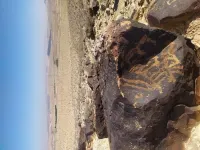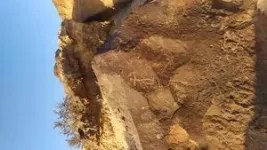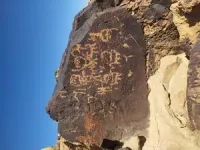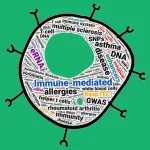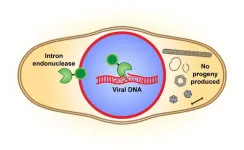(Press-News.org) The Negev desert of southern Israel is renowned for its unique rock art. Since at least the third millennium BCE, the hunters, shepherds, and merchants who roamed the Negev have left thousands of carvings (‘petroglyphs’) on the rocks. These figures are mostly cut into ‘desert varnish’: a thin black coating on limestone rock, which forms naturally. Many represent animals such as ibexes, goats, horses, donkeys, and domestic camels, but abstract forms also occur.
Now, a study published in Frontiers in Fungal Biology has revealed that the petroglyphs are home to a community of uncommon specialist fungi and lichens. Unfortunately, these species may pose a serious threat to the rock art in the long term.
"We show that these fungi and lichens could significantly contribute to the gradual erosion and damage of the petroglyphs,” said Laura Rabbachin, a PhD student at the Academy of Fine Arts Vienna in Austria, and the study’s first author.
"They are able to secrete different types of acids that can dissolve the limestone in which the petroglyphs are carved. In addition, the fungi can penetrate and grow within the stone grains, causing an additional mechanical damage.”
Extreme conditions
Rabbachin and colleagues took samples from a petroglyph site in the central-western highlands of the Negev. Here, an average of just 87mm rain falls per year, and temperatures on rock surfaces can soar up to 56.3 °C in summer. The researchers scraped samples from desert varnish next to petroglyphs, from rocks without desert varnish, and from soil near the sampled rocks. They also left petri dishes open near the rocks to capture airborne spores.
The authors identified collected fungi and lichens with two complementary methods. First, they repeatedly cultured fungal material or spores from rocks or soil on plates with one of two different growth media, until they obtained pure isolates for DNA barcoding. Second, they directly performed DNA sequencing of fungal material present in rock or soil samples, without culturing them first. The latter method can detect strains that don’t grow in culture.
Few but destructive species on petroglyphs
Both methods showed that the diversity and abundance of species on rocks bearing petroglyphs was low in comparison with the soil, which suggests that few species are able to withstand the local extremes of drought and temperature.
DNA barcoding of cultured isolates revealed that the petroglyphs harbor multiple species of fungi within the genera Alternaria, Cladosporium, and Coniosporium, while direct sequencing further detected multiple species in the genera Vermiconidia, Knufia, Phaeotheca, and Devriesia. All except Alternaria and Cladosporium are so-called microcolonial fungi, known to thrive in hot and cold deserts around the world. Also abundant were lichens in the genus Flavoplaca.
“Microcolonial fungi are considered highly dangerous for stone artifacts. For example, they have been implicated as a probable cause of the deterioration of stone cultural heritage in the Mediterranean,” said Rabbachin.
“Lichens are also well known to cause rocks to deteriorate and thus to be a potential threat to stone cultural heritage.”
In the surrounding soil and air, the researchers mainly found different, cosmopolitan fungi, but which are known to be able to survive harsh desert conditions through the production of drought-resistant spores.
Documenting threatened rock art is a necessity
Can anything be done to protect the petroglyphs from the slow but destructive work of the observed microcolonial fungi and lichens? This is unlikely, cautioned the authors.
“These natural weathering processes cannot be stopped, but their speed of the weathering process depends heavily on whether and how the climate will change in the future. What we can do is to monitor the microbial communities over time and most importantly, document these valuable works of art in detail,” said Rabbachin’s academic supervisor Prof Katja Sterflinger, the study’s senior author.
END
Desert-loving fungi and lichens pose deadly threat to 5,000-year-old rock art
Famous petroglyphs in the Negev desert are at risk of destruction from biological processes
2024-07-05
ELSE PRESS RELEASES FROM THIS DATE:
Scientists map how deadly bacteria evolved to become epidemic
2024-07-04
Pseudomonas aeruginosa – an environmental bacteria that can cause devastating multidrug-resistant infections, particularly in people with underlying lung conditions – evolved rapidly and then spread globally over the last 200 years, probably driven by changes in human behaviour, a new study has found.
P. aeruginosa is responsible for over 500,000 deaths per year around the world, of which over 300,000 are associated with antimicrobial resistance (AMR). People with conditions such as COPD (smoking-related lung damage), cystic fibrosis (CF), and non-CF bronchiectasis, are particularly susceptible.
How P. aeruginosa evolved from an environmental organism into a ...
Biodegradable biomass-based aerogel for sustainable radiative cooling
2024-07-04
An aerogel made from gelatin and DNA surpasses 100% solar reflectance, yielding exceptional radiative cooling, a new study reports. It is also biodegradable. The novel approach paves the way for high-performance next-generation radiative cooling materials, promoting environmentally friendly advancements in the field. Sustainable, energy-efficient, and environmentally conscious cooling technologies are crucial for adapting to our rapidly warming world. Compared to traditional refrigeration systems, passive radiative cooling technologies consume less energy and emit fewer greenhouse gasses, making them ...
New brain-to-nerve signaling mechanism reveals potential path to migraine pain
2024-07-04
The rapid influx of cerebral spinal fluid (CSF) and protein solutes released during cortical spreading depression (CSD) in the brain activates neurons to trigger aural migraine headaches, according to a new mouse study. The findings identify a novel non-synaptic signaling mechanism between the brain and peripheral sensory system important for migraine. They also suggest potential pharmacological targets for treating the painful disorder. Migraine with aura, or an aural migraine, is a distinct headache disorder that can include sensory disturbances, such as hearing- or vision-related symptoms that precede onset of ...
Federal grid reforms alone are not enough to solve clean energy interconnection problem
2024-07-04
Although energy production from wind and solar has grown rapidly in the United States, its integration into the national electric grid has been impeded by poor grid interconnection policies, leaving thousands of new facilities for generating renewable energy waiting to be connected to the grid. In a Policy Forum, Les Armstrong and colleagues highlight the interconnection problem and discuss whether federal grid policy reforms alone are enough to address it. Armstrong et al. argue that while the US Federal Energy Regulatory Commission’s (FERC) recent orders to improve this bottleneck are a step in the right direction, fundamental issues remain unaddressed. In the ...
Uncovering “blockbuster T cells” in the gut wins NOSTER & Science Microbiome Prize
2024-07-04
In the gut, dozens of strains of bacteria exert different effects on the immune system that in turn impact our health – fending off pathogens, helping digest food and maybe even influencing behavior. But pinpointing which bacteria exert which effects has been challenging. Better understanding this process could lead to a powerful way to treat a host of diseases. For developing a method by which to zero in on individual gut bacterium’s impacts on T cells, Kazuki Nagashima, a senior research scientist at Stanford University, is the winner of this year’s NOSTER & Science Microbiome ...
Study reveals brain fluid dynamics as key to migraine mysteries, new therapies
2024-07-04
New research describes for the first time how a spreading wave of disruption and the flow of fluid in the brain triggers headaches, detailing the connection between the neurological symptoms associated with aura and the migraine that follows. The study also identifies new proteins that could be responsible for headaches and may serve as foundation for new migraine drugs.
“In this study, we describe the interaction between the central and peripheral nervous system brought about by increased concentrations of proteins released ...
Scientists discover new T cells and genes related to immune disorders
2024-07-04
Researchers led by Yasuhiro Murakawa at the RIKEN Center for Integrative Medical Sciences (IMS) and Kyoto University in Japan and IFOM ETS in Italy have discovered several rare types of helper T cells that are associated with immune disorders such as multiple sclerosis, rheumatoid arthritis, and even asthma. Published July 4 in Science, the discoveries were made possible by a newly developed technology they call ReapTEC, which identified genetic enhancers in rare T cell subtypes that are linked to specific immune ...
The dawn of the Antarctic ice sheets
2024-07-04
In recent years global warming has left its mark on the Antarctic ice sheets. The "eternal" ice in Antarctica is melting faster than previously assumed, particularly in West Antarctica more than East Antarctica. The root for this could lie in its formation, as an international research team led by the Alfred Wegener Institute has now discovered: sediment samples from drill cores combined with complex climate and ice-sheet modelling show that permanent glaciation of Antarctica began around 34 million years ago – ...
Not so selfish after all: Viruses use freeloading genes as weapons
2024-07-04
Curious bits of DNA tucked inside genomes across all kingdoms of life historically have been disregarded since they don’t seem to have a role to play in the competition for survival. Or so researchers thought.
These DNA pieces came to be known as “selfish genetic elements” because they exist, as far as scientists could tell, to simply reproduce and propagate themselves, without any benefit to their host organisms. They were seen as genetic hitchhikers that have been inconsequentially passed ...
Researchers identify unknown signalling pathway in the brain responsible for migraine with aura
2024-07-04
A previously unknown mechanism by which proteins from the brain are carried to a particular group of sensory nerves causes migraine attacks, a new study shows. This may pave the way for new treatments for migraine and other types of headaches.
More than 800,000 Danes suffer from migraines – a condition characterised by severe headache in one side of the head. In around a fourth of all migraine patients, headache attacks are preceded by aura – symptoms from the brain such as temporary visual or sensory disturbances preceding the migraine attack by 5-60 minutes.
While ...
LAST 30 PRESS RELEASES:
iPS cells from dish to freezer and back
Deep neural networks enable accurate pricing of American options under stochastic volatility
Collective risk resonance in Chinese stock sectors uncovered through higher-order network analysis
Does CPU impact systemic risk contributions of Chinese sectors? Evidence from mixed frequency methods with asymmetric tail long memory
General intelligence framework to predict virus adaptation based on a genome language model
Antibiotic resistance is ancient, ecological, and deeply connected to human activity, new review shows
Vapes, pouches, heated tobacco, shisha, cigarettes: nicotine in all forms is toxic to the heart and blood vessels
From powder to planet: University of Modena engineers forge a low-carbon future for advanced metal manufacturing
Super strain-resistant superconductors
Pre-school health programme does not improve children’s diet or physical activity, prompting call for policy changes, study finds
Autumn clock change linked to reduction in certain health conditions
AI images of doctors can exaggerate and reinforce existing stereotypes
Where medicine meets melody – how lullabies help babies and parents in intensive care
We may never be able to tell if AI becomes conscious, argues philosopher
AI video translation shows promise but humans still hold the edge
Deep ocean earthquakes drive Southern Ocean’s massive phytoplankton blooms, study finds
Without campus leftovers to pick through, the beaks of this bird changed shape during the pandemic
High-dose antibiotic does not reduce mortality in tuberculous meningitis
How many insects fly in the sky above the USA?
Could cheese protect your brain health?
Who faces more difficulty recovering from stroke?
Colliding galaxies create the brightest, fastest growing black holes at their center
New BrainHealth research reveals tradeoffs on sleep with cannabis use for chronic pain
Aging-US now on ResearchGate, enhancing visibility for authors and readers
'Molecular glue' stabilizes protein that inhibits development of non-small cell lung cancer
Mount Sinai Health System is recognized in 2025 Chime Digital Health Most Wired survey
From prey to predator: How carnivores spread beneficial fungi
Menopause symptoms may be frequent and have negative effects, according to female endurance athletes
US Congressmembers’ responses on X to mass shooting events differ along party lines
KAIST-UEL team develops “origami” airless wheel to explore lunar caves
[Press-News.org] Desert-loving fungi and lichens pose deadly threat to 5,000-year-old rock artFamous petroglyphs in the Negev desert are at risk of destruction from biological processes
